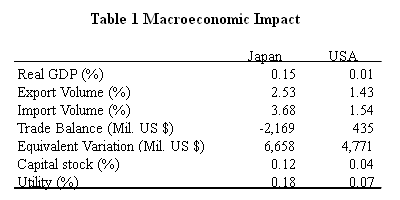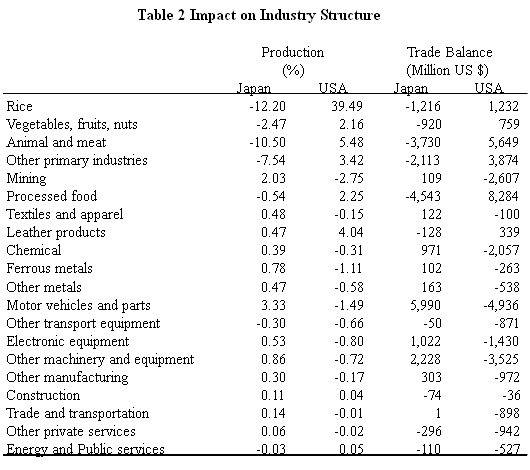March 13, 2003
Activities aimed at bilateral and regional trade agreements have accelerated worldwide in recent years. This essay attempts to present a quantitative analysis on the impact of trade liberalization, via a simulation that uses a Computable General Equilibrium (CGE) model of global trade. It is intended to discuss the impact of bilateral trade liberalization between Japan and the United States, the largest two economies in the world.
A CGE model numerically simulates the general equilibrium structure of the economy. The model provides a framework for assessing the effects of policy and structural changes on resource allocation by identifying the winners and losers from trade. The multi-country model is required to analyze international economic affairs such as trade and investment policies, which affect not just one but a number of economies.
According to conventional simulations by a CGE model of global trade, trade liberalization measures including tariff reductions would stimulate trade by lowering prices on tradable goods. This would result in increases in national output of exporting countries, while increasing access to the markets of trading partners. Meanwhile, domestic production resources--land, capital, labor, and intermediate inputs--would be used more efficiently, as domestic distortions, including those due to trade barriers, are reduced. These combined effects--one from foreign markets and the other from the domestic market--are expected to result in the expansion of production and an increase in income and welfare.
There are several common findings in earlier simulation studies on the impact of trade liberalization by means of a CGE model simulation. It is generally expected that developing economies are the champions in those economic gains from global trade liberalization. Free rider gains could be limited; it is therefore essential to liberalize one's own individual markets to enjoy the benefits from trade liberalization. In comparison with the benefits of global trade liberalization, those of bilateral trade liberalization between certain economies would be limited. It may be rational that regional FTAs would be thought of as steps toward global trade liberalization rather than as a final goal. Those improvements in economic welfare would be smaller in case of partial liberalization, such that just in certain sectors. Wider trade liberalization in a non-discriminative manner would be much more beneficial.
The macroeconomic impact of bilateral trade liberalization between Japan and the United States is summarized in Table 1. Although trade volumes for both exports and imports would be stimulated by a sizable amount, increases in real GDP could be relatively limited. This is not surprising because production in different sectors competes for a limited supply of labor, capital, and land. An expansion of one sector would be accompanied by a contraction of another sector, except when the expansion is the result of significant resource accumulation or technological improvements.
It may be noted that Japanese trade balance is shown to deteriorate, while there would be an improvement in the United States, although marginally. These indicate an international capital inflow in Japan, and an outflow in the Unites States. These asymmetric features are one reason to differentiate the magnitude of macroeconomic impact between the two countries in terms of capital formation, and therefore economic growth.

In addition, trade liberalization measures would result in a realignment of regional production. In principle, it would be in accordance with comparative advantage of the regions. Yet this impact may more likely be determined by the degree of import liberalization in the case of regional and partial trade liberalization.
The current simulations highlight the winners and the losers from the bilateral trade liberalization between Japan and the United States, which are shown in Table 2. In Japan, the agricultural and food sectors would shrink, while the machinery and equipment sectors in general and auto and electric machinery sectors in particular would expand. On the other hand, the opposite effects would take place in the United States.
It should be noted that reallocation of resources to more productive uses involves adjustment costs. Implementation of trade liberalization measures would result in the displacing of employment across industries within the economies. Employment in obsolete industries declines, harming workers in those industries. In a rapidly changing economy, some of these workers may find themselves without the skills required for the new jobs being created.

Kenichi Kawasaki
Consulting Fellow
Research Institute of Economy, Trade and Industry (RIETI)
Editor-in-Chief, Ichiro Araki
Director of Research
Research Institute of Economy, Trade and Industry (RIETI)
e-mail: araki-ichiro@rieti.go.jp
tel: 03-3501-8248 fax: 03-3501-8416
RIETI invites you to visit its English website
[http://www.rieti.go.jp/en/index.html].
The opinions expressed or implied in this paper are solely those of the author, and do not necessarily represent the views of the Ministry of Economy, Trade and Industry (METI), or of the Research Institute of Economy, Trade and Industry (RIETI).

